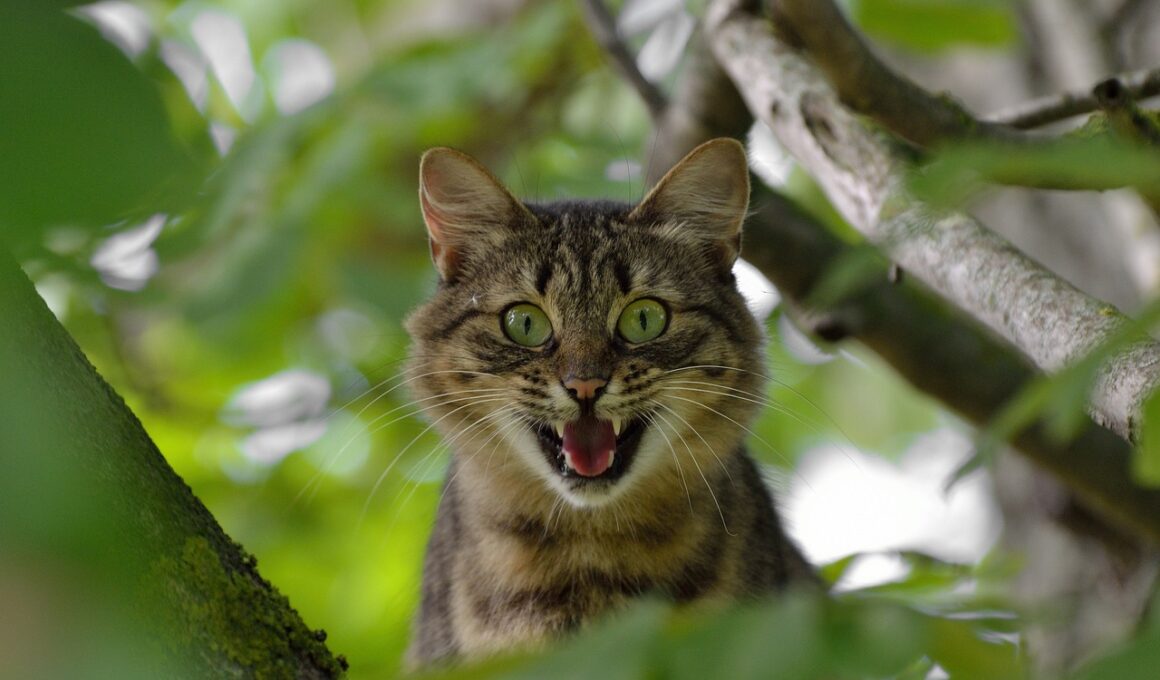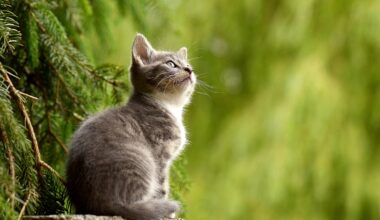Understanding Maternal Aggression in Female Cats
Materal aggression in female cats is a behavior that can often leave pet owners bewildered. Understanding this phenomenon is crucial for fostering a harmonious home. Maternal aggression typically appears in mothers with kittens, particularly when they feel their young are threatened. Factors including genetics and environment play significant roles. Stress, noise, or other pets can trigger aggression too. The behavior manifests through various means, such as hissing, growling, or swatting at perceived threats. Training and management are vital in addressing these issues. First, assess why the aggression occurs. Often, mothers are protective of their territory and offspring. It’s crucial to understand the cat’s body language to predict aggressive reactions. This includes ears pinned back, puffed tails, and vocalizations. Managing the environment is essential for a smoother coexistence. Creating safe spaces for the mother and her kittens can greatly reduce stress levels. Moreover, consider using calming products, such as pheromone diffusers, which can help ease anxiety. Addressing maternal aggression with patience and understanding leads to a more positive relationship with your feline companion.
Understanding the causes of maternal aggression in female cats can help owners take preventive measures. One fundamental factor is hormonal changes due to pregnancy or lactation. These changes can heighten a mother cat’s protective instincts, making her aggressive toward perceived threats. Females that are overly protective might feel insecure about their kittens’ safety, prompting aggressive reactions. Another contributing element is socialization during kittenhood. Kittens raised in stressful environments may become more prone to aggression in adulthood. It is helpful to provide early socialization, exposing kittens to various stimuli, which can help reduce aggressive tendencies later. Additionally, the presence of other pets can impact a mother cat’s behavior. If other animals are introduced suddenly, the mother may respond aggressively to defend her territory. Moreover, past trauma can surface in cats, causing unpredictable behavior. Owners must observe their cats closely, identifying patterns or triggers for aggression. Regular veterinary check-ups are important too, as health issues can provoke behavioral changes. An enriched environment also contributes positively to their well-being, reducing stresses that could lead to aggression. Ultimately, understanding these factors will lead to better management of a cat’s maternal instincts.
Managing maternal aggression requires a consistent approach and patience. First and foremost, identify your cat’s triggers. Observing her interactions can provide insights into what causes aggressive behavior. If specific stimuli provoke aggression, such as certain sounds or the presence of other animals, you can work to minimize these triggers. Gradually desensitizing the mother to these stimuli may help mitigate aggressive reactions. Moreover, providing a safe, quiet environment for her and her kittens is vital. This means having a separate, secure space away from other pets or loud noises. Regular handling of the kittens can help the mother adjust to human interaction, promoting socialization and trust. Positive reinforcement techniques can also be effective in managing aggression. Rewarding the mother for calm behavior with treats or praise encourages her to associate positive experiences with the presence of perceived threats. Consistent routines give her a sense of security, reducing anxiety levels. If aggression persists despite these efforts, consulting with a veterinary behaviorist may provide tailored strategies. Establishing a bond of trust is key; building this relationship through careful management allows you to navigate maternal aggression more effectively.
Signs of Maternal Aggression
Recognizing signs of maternal aggression is crucial for ensuring the well-being of both your cat and her kittens. The typical signs include posturing, vocalizations, and protective behaviors. A mother cat may hiss or growl loudly if she perceives a threat to her kittens. Additionally, she might swat or act defensively when approached by unfamiliar people or animals. Watch for her body language, which can reveal her state of mind. A cat displaying a puffed-up tail and flattened ears is likely frightened or agitated. Also, spending excessive time on high perches or hiding spots can indicate stress. Notably, if the mother cat is constantly on guard, this behavior is significant. She may also refuse food or water as a sign of distress, reducing her ability to care for her kittens effectively. It’s essential for owners to remain calm and avoid approaching her aggressively during this time; patience is key. Offer her quiet spaces where she feels safe. Creating a nurturing environment promotes a tranquil atmosphere, ultimately benefiting her and her kittens. By understanding these signs, owners can intervene appropriately and help reduce maternal aggression.
Another way to address maternal aggression is through early socialization and handling. Getting accustomed to human presence and other pets can significantly influence the mother cat’s behavior. Begin the process while she is still pregnant, allowing her to explore new experiences safely. After the kittens are born, continue handling them regularly to assist in their development. It’s important to manage this interaction carefully, ensuring you don’t overwhelm her or disrupt her protective instincts. Use gentle movements and reassuring tones, which can help build a positive association for the mother. The more she feels comfortable with human activities, the less likely she will be to react aggressively when challenges arise. Furthermore, teaching other pets to respect the mother cat’s space is equally important. Introducing them gradually can minimize the potential for confrontations. Also, consider creating designated areas where she can retreat without being disturbed. By providing safe zones for her and her kittens, you minimize triggers for aggression, leading to a calmer household atmosphere. This attention to socialization not only benefits the mother cat but creates a positive environment for the growing kittens.
Consulting a Professional
Sometimes, despite your best efforts, maternal aggression in female cats may require professional assistance. Consulting a veterinarian or behaviorist can offer tailored solutions to address this serious concern. A behaviorist can provide insights into the specific challenges faced based on the unique character of your cat. They utilize behavior modification techniques that create a safer environment for both the mother and her kittens. Additionally, they can assess various factors contributing to aggression, ensuring that all angles are considered. It’s important to emphasize that aggressive behaviors can stem from a mixture of environmental and genetic influences. Early intervention can prevent these behaviors from escalating over time. Regular updates to the behaviorist will help track progress and make necessary adjustments to strategies. Be prepared for ongoing observations and follow-ups; success doesn’t happen overnight. The process may take time and requires commitment from the owners. Utilizing a professional also provides peace of mind, knowing you are taking the right steps toward resolving the issue. In summary, a collaborative approach between owners and professionals can significantly enhance the management of maternal aggression.
Maintaining a stress-free environment plays a crucial role in managing maternal aggression in female cats. Stress can exacerbate aggressive behaviors; therefore, ensuring consistency in routines can be beneficial. Feeding schedules, playtimes, and quiet times should remain predictable. This helps create a comforting atmosphere, reducing anxiety and potential aggression triggers. Another effective strategy is providing adequate resources; this includes separate feeding stations, litter boxes, and resting places for your cat. If multiple pets exist in the home, ensuring they each have their territories can reduce competition and aggressive outbursts. Additionally, it’s vital to minimize disruptions, especially during the early weeks after birth, as this period is crucial for bonding between the mother and her kittens. Furthermore, considering the use of calming products like pheromone diffusers can create a relaxed environment—essential when managing a cat’s stress levels. Providing activities that encourage mental stimulation can also serve as a distraction, redirecting energy away from aggression. Ultimately, prioritizing a soothing living space enhances your ability to manage maternal aggression effectively, leading to a happier household dynamic. Owners who invest in these strategies contribute significantly to the emotional and physical well-being of their feline family members.
Conclusion
In conclusion, understanding maternal aggression in female cats is vital for all cat owners. Recognizing the triggers and signs of this behavior allows owners to take proactive measures. Through effective management of the environment, early socialization, and consulting professional behaviorists, it is possible to reduce aggressive tendencies. Moreover, fostering a stress-free space not only benefits the mothers but also contributes to the well-being of their kittens. Observing the nuances of feline behavior is essential for building trust and improving relationships with our pets. Each mother cat is unique, and what works for one may not work for another, requiring patience and adaptability. By investing time, effort, and knowledge into addressing maternal aggression, owners create a more harmonious home environment. Continually learning about feline behavior supports a nurturing and respectful relationship between cats and their caregivers. Remember, the goal is not only to manage aggression but to promote a positive, loving bond with your feline companions. Adopting these strategies can significantly enhance the lives of both the mother cat and her kittens. A peaceful household ensures that all family members thrive, leading to happiness and contentment.


